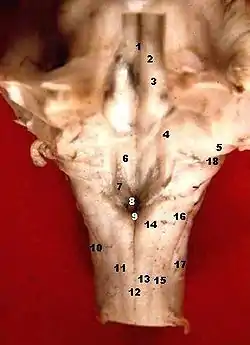Lateral aperture
The lateral aperture is a paired structure in human anatomy. It is an opening in each lateral extremity of the lateral recess of the fourth ventricle of the human brain, which also has a single median aperture. The two lateral apertures provide a conduit for cerebrospinal fluid to flow from the brain's ventricular system into the subarachnoid space; specifically into the pontocerebellar cistern at the cerebellopontine angle. The structure is also called the lateral aperture of the fourth ventricle or the foramen of Luschka after anatomist Hubert von Luschka.[1]
| Lateral aperture | |
|---|---|
 Animation showing the fourth ventricle (in red). The little points sticking out on the left and right are the two parts of the lateral recess, which end in the foramen of Luschka. | |
 Human caudal brainstem posterior view (Lateral aperture is #18) | |
| Details | |
| Identifiers | |
| Latin | apertura lateralis ventriculi quarti |
| Acronym(s) | LA4V |
| NeuroNames | 640 |
| TA98 | A14.1.05.718 |
| TA2 | 5969 |
| FMA | 78473 |
| Anatomical terms of neuroanatomy | |
Gross total resection of tumours that extend through foramen of Lushka is sometimes not possible due to bradycardia.[2]
References
| Wikimedia Commons has media related to Lateral aperture. |
This article incorporates text in the public domain from page 798 of the 20th edition of Gray's Anatomy (1918)
- Hubert Von Luschka at whonamedit.com
- Greenberg, Mark. Handbook of Neurosurgery (Seventh ed.). Thieme publishers. p. 684. ISBN 978-1-60406-326-4.